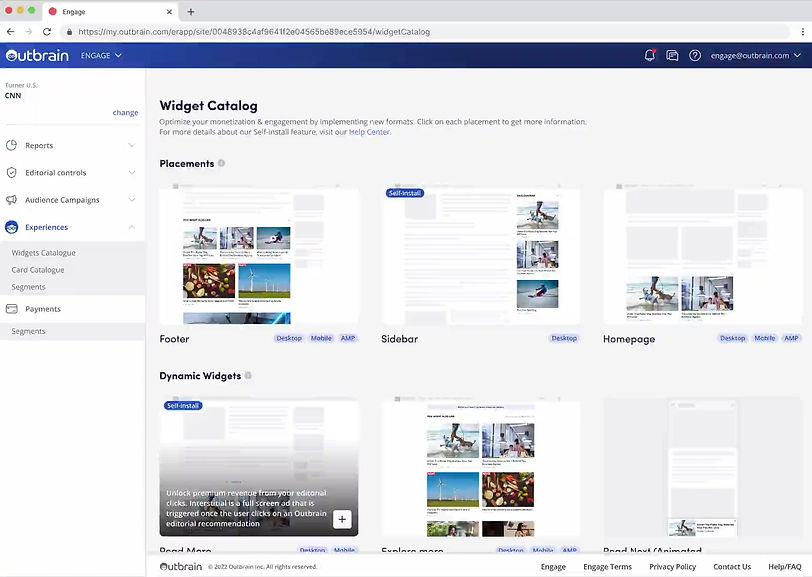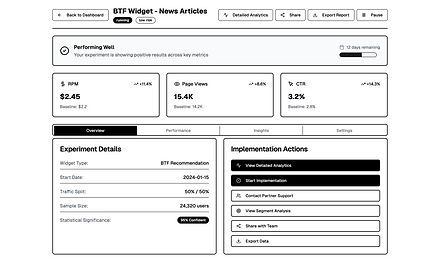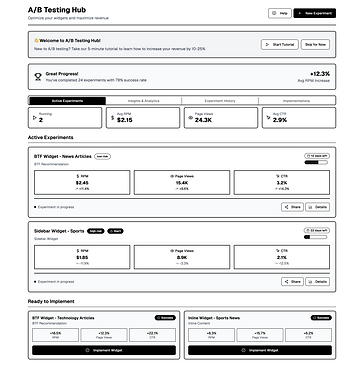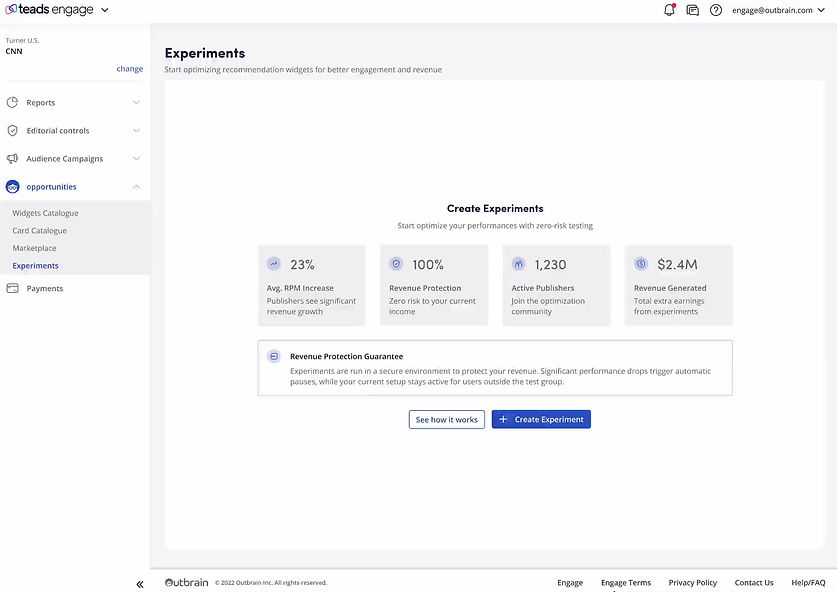
INTRODUCTION
About the
Product

Engage Dashboard is a leading platform for native advertising and content discovery.
The Engage dashboard serves as a central hub for publishers to manage and optimize their content monetization and audience engagement strategies.
Responsibility
I joined the product a year ago when I started working at Teads.
The product was already live and serving many publishers.
My role focused on designing new features from the roadmap and developing strategies for upsell opportunities for publishers through DIY.
I also conducted user interviews, usability tests, and analyzed user behavior, working closely with project managers, analysts, developers, and quality assurance to ensure a smooth product experience.
Goals
Help publishers maximize revenue
The main design goal was to provide publishers with a seamless and intuitive experience, enabling them to accomplish key tasks—like tracking ad performance, accessing insights, and optimizing monetization strategies—quickly and with minimal effort
Upsell opportunities through DIY abilities
Another goal was to empower publishers to achieve their business objectives by creating new upsell opportunities. Most Engage publishers rely on static ads, so I focused on enabling them to build dynamic ad units, integrate with third-party tools, and manage the process independently.
Personas & Segments
The engaged user segment is referred to as "Publishers." Each segment consists of different groups of users who share Engage's usage. These are the main personas of Engage:
Internal main users:

Publisher Partner Manager
The main point of contact between a platform and its publishers. Their role is to support publishers in their day-to-day operations by helping them optimize performance, troubleshoot issues, and identify new growth opportunities
External main users:

Revenue Manager
work closely with publishers to maximize their revenue potential. They help publishers make smart decisions about ad placements, formats, and pricing strategies. By analyzing performance data and market trends, Monetization Managers provide actionable insights and recommendations that improve yield and efficiency.

C-level Executive
This secondary persona closely resembles the Revenue Manager but holds an executive role (e.g., Chief Revenue Officer, VP of Digital Operations, or VP of Global Partnerships). Their primary focus is high-level performance insights, rather than day-to-day operational tasks like ad blocking or campaign management.

Engage users workshop
In May 2025, we held a 45-minute workshop with six internal Engage users to gather feedback on their experience with the product.
We discussed what’s working, pain points, and suggestions for improvement.
Afterward, I summarized key insights to help optimize the product.

Preparation 🧑🍳
To better prepare, I sent out a short survey a few days before the workshop to identify which features to focus on. This allowed me to tailor the content more closely to the participants' interests and needs.



How does it work? 👨💻
We selected four key product features that users interact with most often. For each, I asked participants to describe their experience briefly. Each session lasted about five minutes, and users wrote their thoughts on sticky notes to capture their impressions.


Empathy experience 😀🙁
I asked them to rate the emotions they felt for each feature to understand better the level of empathy and emotional response it triggered.


Insights & Summary 📃
After the workshop, I gathered and summarized all the feedback to ensure nothing was overlooked. This summary helps inform better product decisions and can be shared with senior management for alignment.

Do It Your Self - DIY
As mentioned, one of the key goals was to empower SMP publishers to independently optimize their performance. To support this, I worked on features such as widget implementation settings for their sites and A/B testing capabilities for dynamic widgets.
Installing & Configuring widgets
Until now, publishers needed help from account managers to configure settings for certain widgets. Configuration was only possible through a Teads account manager.
To support the goal of enabling upsell opportunities through self-serve (DIY) capabilities, I designed a feature that allows publishers to configure widget settings on their own, without account manager involvement.
Pain Points
One key pain point I identified was the difficulty publishers faced in implementing new widgets easily and consistently. Previously, they had to rely on a partner manager to define each implementation individually, leading to time-consuming back-and-forth and frequent delays.



The Persona
This feature is primarily designed for small to medium-sized publishers (SMPs), who tend to be more hands-on and engaged with the product. They often have more time and flexibility to explore and configure settings themselves, making self-serve capabilities a better fit for their workflow.


Widget Experiments (A/B Test)
This feature allows publishers to A/B test across multiple recommendation cards and widgets to assess their effectiveness in driving key performance metrics such as RPM (revenue per mile), page views, and CTR (click-through rate). Additionally, the feature offers a preview or prediction tool that shows the potential impact of each widget before implementation, allowing publishers to strategically select the most promising options in advance.
Pain Points
The main pain point I identified when addressing this problem is that users aren’t receiving enough quality information about the widget’s performance. They are often unaware of its full capabilities, which also presents us with opportunities to upsell to the user.

Challenges
Publishers are often set in their ways and resistant to new optimization processes
Low signup rates, high abandonment during onboarding, and reluctance to implement winning variants.
Fear of disrupting existing revenue streams, comfort with status quo
Publishers expect immediate results and abandon tests too early
Pressure for quick revenue improvements, misunderstanding of testing timelines.
Invalid test results, poor optimization outcomes
Accurate tracking and attribution across different devices and sessions
Inconsistent metrics, discrepancies with other analytics tools.
Unreliable insights, user skepticism about platform accuracy
Significant portion of users block tracking and ads
Incomplete data, skewed results, reduced test validity
Widespread ad blocker adoption, privacy concerns
Data reliability issues, optimization blind spots
Ideation & sketches
After analyzing her problem, I developed initial ideas and directions for the feature. I drew inspiration from competitors with similar products, AI generator tools, and feedback from colleagues.





User Interface
After finalizing the concepts, I translated the ideas into functional designs and brought them to life. To ensure consistency across the product, I used design elements from the Engage system.
* As mentioned earlier, I'm unable to showcase the full feature due to confidentiality.
Below are the designs I’m authorized to share.






Monitoring & Usability
To track user behavior, I use a tool called FullStory.
It allows me to monitor user interactions, identify unusual actions, spot bugs, and recognize patterns of successful behavior. FullStory also helps me assess whether existing features need improvement or if new features should be introduced based on user activity.
Example 1:
For example, I created a funnel to track how many users move from the Performance page → to the Campaigns page → and then create an Organic Campaign.
As shown, there’s a significant drop-off (82.83%) between the first and second steps, suggesting that the navigation to the Campaigns page likely needs improvement.


Example 2:
In this example, the search funnel tracks users who go from the performance page → open the notifications window → click on the notification and navigate to the intended page.
The data revealed a significant drop-off between the first and second stages, with a 98.91% drop in user engagement.
To address this, I introduced an additional notification channel via email, alongside in-app notifications. This change reduced user churn by about 17%.




The highlights of Engage
Here are some of the main interface screens from the product.

Performance Page
This is the page where users spend most of their time. It plays a key role in their workflow, allowing them to analyze site performance and make data-driven optimizations.


Editorial Control - Filter Content
This feature allows publishers to manage their content, allowing them to block or approve previously blocked ads. They can also block ads based on keywords, links, domains, and more. It’s a highly used page and a key tool for publishers in maintaining content quality.
Widgets Catalog
This screen displays all available widgets that users can install on their site.
Dynamic widgets can be installed either by an account manager or through DIY, while static widgets currently require installation by an account manager.
It serves as a central hub for users to explore and evaluate which widgets best fit their site’s needs.
